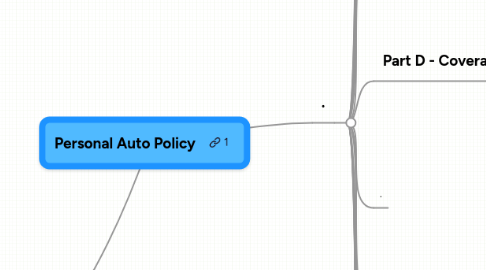
1. .
1.1. Part A - Liability Coverage
1.1.1. Pay damages for bodily injury or property damage for which any insured becomes legally responsible.
1.1.2. .
1.1.3. Settle or defend any claim or suit asking for such damages
1.1.4. .
1.2. .
1.3. Part B - Medical Payments
1.3.1. Insuring Agreement
1.3.1.1. medical and funeral services within 3 years
1.3.1.2. .
1.3.1.3. insured
1.3.1.3.1. The named insured or any family member occupying any auto or as a pedestrian when struck by a motor vehicle
1.3.1.3.2. .
1.3.1.3.3. Any person such as a passenger while occupying the insured auto
1.3.1.4. .
1.3.1.5. Exclusions
1.3.1.5.1. fewer than 4 wheels.
1.3.1.5.2. .
1.3.1.5.3. vehicle used during the course of employment
1.3.1.5.4. .
1.3.1.5.5. A vehicle, other than the covered vehicle
1.3.1.5.6. .
1.3.1.5.7. occupied without a reasonable belief that the insured has permission to do so
1.3.1.5.8. .
1.4. .
1.5. Part C - Uninsured Motorist
1.5.1. Insuring Agreement
1.5.1.1. insurer will pay damages that an insured is legally entitled to recover from the owner or operator of an uninsured motor vehicle because of bodily injury
1.5.1.2. .
1.5.1.3. vehicle that is uninsured at the time of the accident; a hit-and-run vehicle; or a vehicle for which there is a liability policy or bond in force at the time of accident, but the insurer denies coverage, becomes insolvent
1.5.1.4. .
1.5.1.5. Exclusions
1.5.1.5.1. fewer than 4 wheels.
1.5.1.5.2. .
1.5.1.5.3. vehicle used during the course of employment
1.5.1.5.4. .
1.5.1.5.5. A vehicle, other than the covered vehicle
1.5.1.5.6. .
1.5.1.5.7. occupied without a reasonable belief that the insured has permission to do so
1.5.1.5.8. .
1.6. .
1.7. Part D - Coverage for Damage to Your Auto
1.7.1. PD refers to property damage
1.7.1.1. .
1.7.1.2. Collision
1.7.1.2.1. Pays damages to your vehicle from colliding with another auto or tree
1.7.1.3. .
1.7.1.4. Comprehensive
1.7.1.4.1. Is now called OTC = other then Collision
1.7.2. .
1.8. .
1.9. Part E - Duties After an Accident or Loss
1.9.1. 1. The insured must: a. Notify the insurer promptly of how, when, and where an accident or loss happened. b. Cooperate with the investigation and settlement of any claim. c. Promptly send to the insurer any copies of notices or legal papers received. d. Submit to a physical exam as required by the insurer. e. Authorize the insurer to obtain medical reports and other pertinent records. f. Submit a proof of loss when required by the insurer. 2. When seeking Uninsured Motorists Coverage, the insured must promptly notify the police if a hit-and-run driver is involved. 3. An insured making a claim under Part D must protect the property from further damage, notify the police promptly if the vehicle is stolen, and allow the insurer to inspect and appraise the damaged vehicle before its repair or disposal.
1.10. .
1.11. Part F - General Provisions
1.11.1. Termination
1.11.1.1. b. The insurer may cancel the policy by mailing notice to the named insured shown on the Declarations. Notice of at least 10 days is required for cancellation due to nonpayment of premium, and at least 20 days in all other cases. c. After the policy has been in effect for 60 days, the insurer may cancel only for the following reasons: 1) Nonpayment of premium. 2) A substantial increase in hazard. 3) The policy was obtained through fraud or material misrepresentation. 4) The insured’s drivers license is suspended or revoked. 2. Nonrenewal – The insurer may nonrenew the policy for the same reasons a policy may be cancelled by giving notice before the end of the policy period. The reason for cancelling must be clear and simple, and the insurer cannot refuse to renew solely because of age. Note: In California, insurers must give at least 30 days’ notice before the end of the policy period in the case of nonrenewal. In the event an insurer fails to give the named insured either an offer of renewal or notice of nonrenewal as required, the existing policy shall remain in effect for 30 days from the date that either the offer to renew or the notice of nonrenewal is delivered or mailed to the named insured. There shall be no change in its terms and conditions during those additional days.
1.11.1.2. .
1.11.1.3. 3. Automatic Termination – If the insurer offers to renew the policy, the policy will automatically terminate at the end of the policy period if the insured does not accept the renewal offer. 4. Other Termination Provisions a. Proof of mailing of any notice constitutes sufficient proof of notice. b. If the policy is cancelled, the insured may be entitled to a premium refund. If so, the insurer will send the refund. c. The effective date of cancellation stated in the notice will become the end of the policy period.
1.12. ,
1.13. Selected Endorsements
1.13.1. The endorsement can be used to provide excess liability coverage for public or livery use of a non-owned vehicle.
1.14. .
1.15. Miscellaneous Type Vehicle Endorsement
1.15.1. 1. This endorsement amends the definition of covered auto to include motorcycles, motor homes, golf carts, all-terrain vehicles (ATVs), and dune buggies. The definition does not include snowmobiles. 2. The endorsement ex
